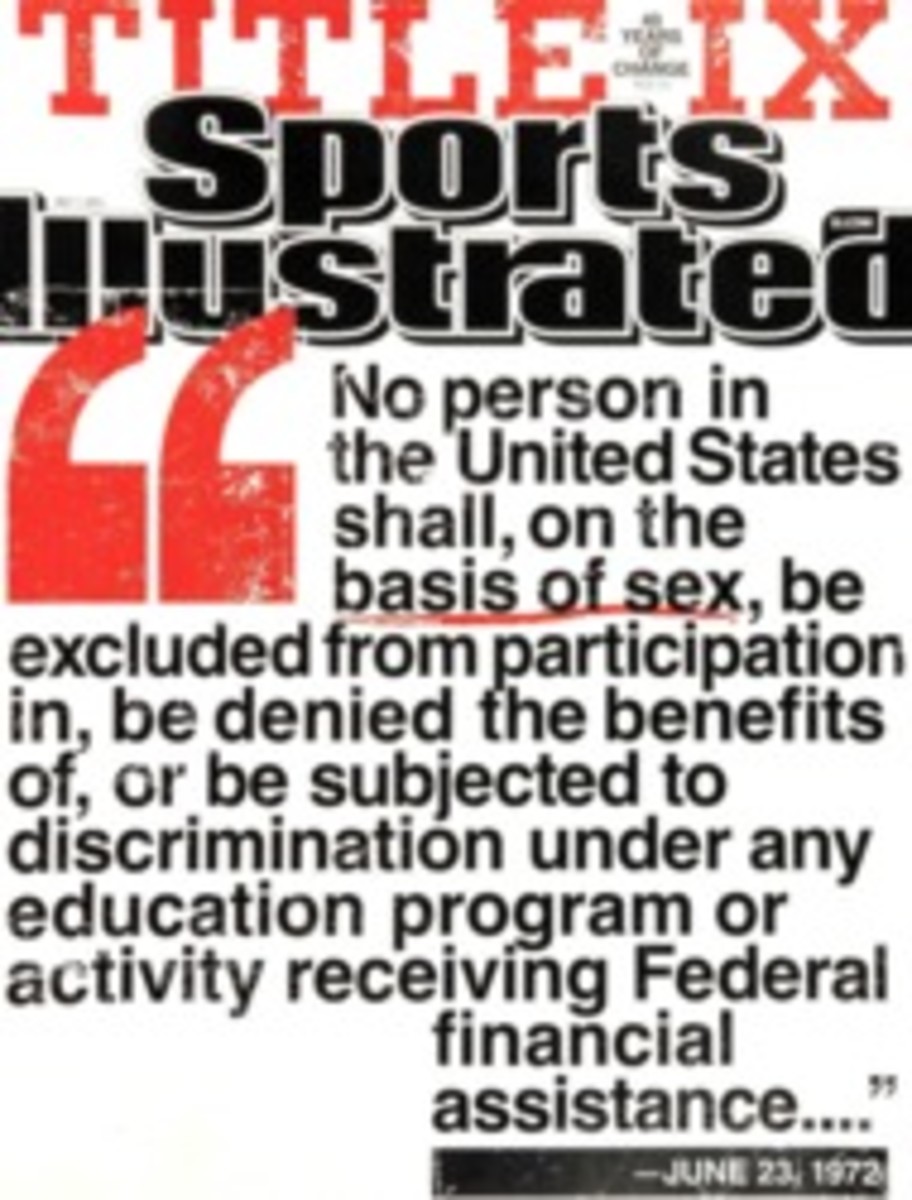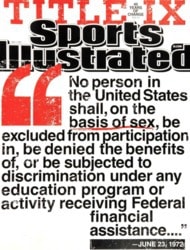
The Power of Play
The 1996 Olympics by Kelli Anderson
Yale Rowers by Michael Bamberger
Maria Pepe by Melissa Segura
The Title IX Babies by Phil Taylor
Political Football by Alexander Wolff
Battle of the Sexes by L. Jon Wertheim
The AIAW by George Dohrmann
Father Figures by Alexander Wolff
Sharon Berg by Nancy Ramsey
At night, when practice was over, the dreaming would begin. After Tara VanDerveer and the three Indiana basketball teammates she roomed with in the winter of 1974 had wolfed down plates of Hamburger Helper, they'd sit around their dinette table and ask, What if? What if they could have gotten scholarships? What if they traveled by air instead of vans, competed in sold-out arenas, were seen by far-flung friends and relatives on TV? Imagine getting paid to play! A pro draft! "We'd laugh about it," says VanDerveer, now 27 years into her tenure as the women's basketball coach at Stanford. "At the time it was all total, total fantasy."
Around the country other frustrated, underfunded and unappreciated female athletes were dreaming, too. Countless more girls were confined to sandlots and backyard hoops, banned from youth leagues and varsities. They weren't aware of it yet, but legislation that would make so many of their reveries real was already law.
First proposed by Oregon representative Edith Green and educator Bernice Sandler as a way to expand opportunities in higher education for women, the statute known as Title IX had been drafted and introduced by Hawaii representative Patsy Mink, championed by Indiana senator Birch Bayh and signed into law by President Richard Nixon on June 23, 1972. The 37 words that form the basis of the legislation, part of the Education Amendments of 1972, read, "No person in the United States shall, on the basis of sex, be excluded from participation in, be denied the benefits of, or be subjected to discrimination under any educational program or activity receiving Federal financial assistance."
While the effect on opportunities in education has been profound—the number of law and medical degrees going to women has jumped from 7% and 9%, respectively, in 1972 to 47% and 48% in 2010—the athletic gains have been seismic. According to a report provided by the Women's Sports Foundation, 294,015 girls competed in high schools four decades ago. By last year the number had ballooned to 3,173,549, and it's growing.
Still, there's work to do. Opportunities in high school have increased for both girls and boys, but girls have 1.3 million fewer chances to play. Many coaching jobs that once went to women are now claimed by men. Inequities in resources, and resistance to equal access for women, persist. But the benefits of Title IX, to women and to society, are almost incalculable. Girls who compete in sports get better grades, graduate at higher rates and have more confidence. The vast majority avoid unplanned pregnancies, drugs, obesity, depression and suicide. Two generations of female athletes—who once could venture no closer than the sideline—have felt the adrenaline rush of competition, learned the value of teamwork, pushed themselves to their physical limits, then coped with the consequences of victory and defeat. They have earned recognition, received scholarships, inspired celebration—even, yes, been drafted and made a living from their talent.
Forty years of Title IX have produced thrilling moments in myriad sports, some small and personal and some, as the following pages show, socially transforming.
Because of 37 words, millions of dreams have become reality. There's still room for millions more.
PHOTO ILLUSTRATION
Photograph by ROBERT BECK
Illustration by MICHAEL MYERS
HEAR THE ROAR: U.S. WOMEN WIN THE WORLD CUP: PASADENA, 1999 Brandi Chastain's moment in the sun was much more than a spontaneous outburst of the joy of victory—it was an iconic expression of the ideals behind the law that sparked a women's sports revolution when it was passed 27 years earlier.
PHOTO
LONNIE TIMMONS III/THE PLAIN DEALER/LANDOV
AND MANY WILL FOLLOW: REVERE INVITATIONAL CROSS-COUNTRY MEET: BATH, OHIO, 2010 In 1972--73, the first school year under Title IX, more than 12 times more boys than girls played high school sports. By 2010 the gap had shrunk: While boys' participation was at a record level, they outnumbered girls by a relatively scant 29%.
PHOTO
WINSLOW TOWNSON
BREAKING THE ICE: DUXBURY HIGH'S MASSACHUSETTS DIVISION 2 CHAMPIONSHIP TEAM: BOSTON, 2012 In the Title IX era, participation by girls in sports once reserved for boys has soared: In ice hockey, for example, 8,254 girls played on high school teams in 2009--10, up from a total of just 96 in 1973--74.
PHOTO
SCOTT SERIO/ECLIPSE SPORTSWIRE/ZUMAPRESS.COM
LONG ARM OF THE LAW: JOELLE ARRANTE, RISING SUN HIGH: NORTH EAST, MD., 2012 Title IX's effects extend into the classroom and beyond: Research suggests that the legislation has contributed to the rise in the number of women who work full time and who have moved into formerly male-dominated occupations.
PHOTO
AUTUMN CRUZ/SACRAMENTO BEE/ZUMAPRESS.COM
STILL PLAYING CATCH-UP: DAVIS HIGH VS. ST. FRANCIS, DIVISION I SAC-JOAQUIN SECTION FINAL, ELK GROVE, CALIF., 2011 Even with the advances spurred by Title IX, a physical-activity gender gap remains: 39% of young boys exercise six or seven days a week, compared with 26% of young girls.
PHOTO
ANA P. GUTIERREZ/THE ORANGE COUNTY REGISTER/ZUMAPRESS.COM
ENGINEERING SUCCESS: FULLERTON INTERNATIONAL RUGBY TOURNAMENT: FULLERTON, CALIF., 2012 Studies show that female high school athletes are more likely than nonathlete girls to do well in science classes, and those who play what are often thought of as boys' sports may perform better in science classes than girls in stereotypically feminine sports.
PHOTO
LIZ FORREST
THE POWER OF MANY: CHESHIRE HIGH SWIM TEAM: CHESHIRE, CONN., 2007 The more time girls spend participating in team sports, studies suggest, the higher their levels of self-esteem—a linkage that has not been found in individual sports.
PHOTO
HEINZ KLUETMEIER
FORWARD-LOOKING: PENN RELAYS, HIGH SCHOOL 4...400 METERS: PHILADELPHIA, 2012 Research shows that girls who play high school sports are more likely than nonathletes to complete college, and less likely to use drugs or become pregnant or obese in adolescence.
PHOTO
DAMIAN STROHMEYER
EARLY ADOPTERS: ARLINGTON HIGH LACROSSE TEAM: ARLINGTON, MASS., 2012 While Title IX ensures opportunities for female athletes in high school and college, it's crucial that the spirit of the law reach younger children: One study has shown that if a girl doesn't participate in sports by age 10, there's only a 10% chance she will participate at age 25.
PHOTO
AL TIELEMANS
WORK TO BE DONE: OCEAN CITY (N.J.) HIGH CREW: PHILADELPHIA, 2012 The law has brought more gender balance to college sports, but a 2005--06 study showed that women made up less than 45% of the athlete population at NCAA schools while accounting for 55% of the student body.

